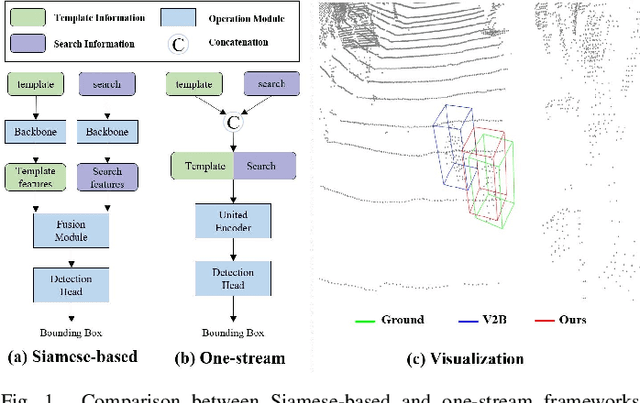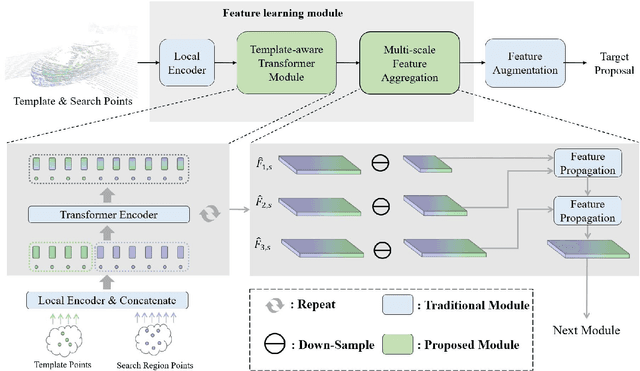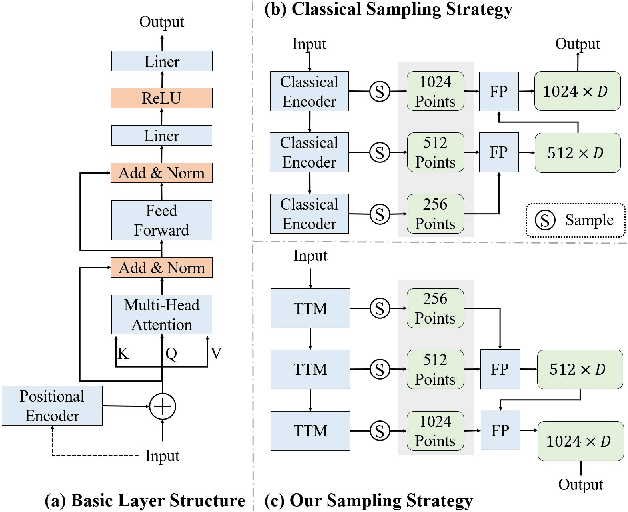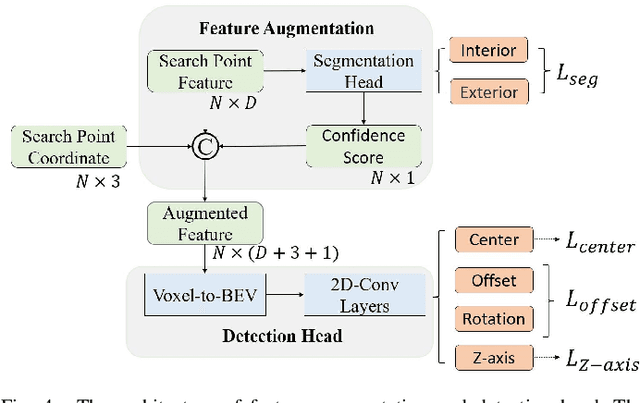Shengjing Tian
Robust Single Object Tracking in LiDAR Point Clouds under Adverse Weather Conditions
Jan 13, 2025



Abstract:3D single object tracking (3DSOT) in LiDAR point clouds is a critical task for outdoor perception, enabling real-time perception of object location, orientation, and motion. Despite the impressive performance of current 3DSOT methods, evaluating them on clean datasets inadequately reflects their comprehensive performance, as the adverse weather conditions in real-world surroundings has not been considered. One of the main obstacles is the lack of adverse weather benchmarks for the evaluation of 3DSOT. To this end, this work proposes a challenging benchmark for LiDAR-based 3DSOT in adverse weather, which comprises two synthetic datasets (KITTI-A and nuScenes-A) and one real-world dataset (CADC-SOT) spanning three weather types: rain, fog, and snow. Based on this benchmark, five representative 3D trackers from different tracking frameworks conducted robustness evaluation, resulting in significant performance degradations. This prompts the question: What are the factors that cause current advanced methods to fail on such adverse weather samples? Consequently, we explore the impacts of adverse weather and answer the above question from three perspectives: 1) target distance; 2) template shape corruption; and 3) target shape corruption. Finally, based on domain randomization and contrastive learning, we designed a dual-branch tracking framework for adverse weather, named DRCT, achieving excellent performance in benchmarks.
Evaluating the Robustness of LiDAR Point Cloud Tracking Against Adversarial Attack
Oct 28, 2024Abstract:In this study, we delve into the robustness of neural network-based LiDAR point cloud tracking models under adversarial attacks, a critical aspect often overlooked in favor of performance enhancement. These models, despite incorporating advanced architectures like Transformer or Bird's Eye View (BEV), tend to neglect robustness in the face of challenges such as adversarial attacks, domain shifts, or data corruption. We instead focus on the robustness of the tracking models under the threat of adversarial attacks. We begin by establishing a unified framework for conducting adversarial attacks within the context of 3D object tracking, which allows us to thoroughly investigate both white-box and black-box attack strategies. For white-box attacks, we tailor specific loss functions to accommodate various tracking paradigms and extend existing methods such as FGSM, C\&W, and PGD to the point cloud domain. In addressing black-box attack scenarios, we introduce a novel transfer-based approach, the Target-aware Perturbation Generation (TAPG) algorithm, with the dual objectives of achieving high attack performance and maintaining low perceptibility. This method employs a heuristic strategy to enforce sparse attack constraints and utilizes random sub-vector factorization to bolster transferability. Our experimental findings reveal a significant vulnerability in advanced tracking methods when subjected to both black-box and white-box attacks, underscoring the necessity for incorporating robustness against adversarial attacks into the design of LiDAR point cloud tracking models. Notably, compared to existing methods, the TAPG also strikes an optimal balance between the effectiveness of the attack and the concealment of the perturbations.
MirrorAttack: Backdoor Attack on 3D Point Cloud with a Distorting Mirror
Mar 09, 2024



Abstract:The widespread deployment of Deep Neural Networks (DNNs) for 3D point cloud processing starkly contrasts with their susceptibility to security breaches, notably backdoor attacks. These attacks hijack DNNs during training, embedding triggers in the data that, once activated, cause the network to make predetermined errors while maintaining normal performance on unaltered data. This vulnerability poses significant risks, especially given the insufficient research on robust defense mechanisms for 3D point cloud networks against such sophisticated threats. Existing attacks either struggle to resist basic point cloud pre-processing methods, or rely on delicate manual design. Exploring simple, effective, imperceptible, and difficult-to-defend triggers in 3D point clouds is still challenging.To address these challenges, we introduce MirrorAttack, a novel effective 3D backdoor attack method, which implants the trigger by simply reconstructing a clean point cloud with an auto-encoder. The data-driven nature of the MirrorAttack obviates the need for complex manual design. Minimizing the reconstruction loss automatically improves imperceptibility. Simultaneously, the reconstruction network endows the trigger with pronounced nonlinearity and sample specificity, rendering traditional preprocessing techniques ineffective in eliminating it. A trigger smoothing module based on spherical harmonic transformation is also attached to regulate the intensity of the attack.Both quantitive and qualitative results verify the effectiveness of our method. We achieve state-of-the-art ASR on different types of victim models with the intervention of defensive techniques. Moreover, the minimal perturbation introduced by our trigger, as assessed by various metrics, attests to the method's stealth, ensuring its imperceptibility.
Small Object Tracking in LiDAR Point Cloud: Learning the Target-awareness Prototype and Fine-grained Search Region
Jan 24, 2024



Abstract:Single Object Tracking in LiDAR point cloud is one of the most essential parts of environmental perception, in which small objects are inevitable in real-world scenarios and will bring a significant barrier to the accurate location. However, the existing methods concentrate more on exploring universal architectures for common categories and overlook the challenges that small objects have long been thorny due to the relative deficiency of foreground points and a low tolerance for disturbances. To this end, we propose a Siamese network-based method for small object tracking in the LiDAR point cloud, which is composed of the target-awareness prototype mining (TAPM) module and the regional grid subdivision (RGS) module. The TAPM module adopts the reconstruction mechanism of the masked decoder to learn the prototype in the feature space, aiming to highlight the presence of foreground points that will facilitate the subsequent location of small objects. Through the above prototype is capable of accentuating the small object of interest, the positioning deviation in feature maps still leads to high tracking errors. To alleviate this issue, the RGS module is proposed to recover the fine-grained features of the search region based on ViT and pixel shuffle layers. In addition, apart from the normal settings, we elaborately design a scaling experiment to evaluate the robustness of the different trackers on small objects. Extensive experiments on KITTI and nuScenes demonstrate that our method can effectively improve the tracking performance of small targets without affecting normal-sized objects.
OST: Efficient One-stream Network for 3D Single Object Tracking in Point Clouds
Oct 16, 2022



Abstract:Although recent Siamese network-based trackers have achieved impressive perceptual accuracy for single object tracking in LiDAR point clouds, they advance with some heavy correlation operations on relation modeling and overlook the inherent merit of arbitrariness compared to multiple object tracking. In this work, we propose a radically novel one-stream network with the strength of the Transformer encoding, which avoids the correlation operations occurring in previous Siamese network, thus considerably reducing the computational effort. In particular, the proposed method mainly consists of a Template-aware Transformer Module (TTM) and a Multi-scale Feature Aggregation (MFA) module capable of fusing spatial and semantic information. The TTM stitches the specified template and the search region together and leverages an attention mechanism to establish the information flow, breaking the previous pattern of independent \textit{extraction-and-correlation}. As a result, this module makes it possible to directly generate template-aware features that are suitable for the arbitrary and continuously changing nature of the target, enabling the model to deal with unseen categories. In addition, the MFA is proposed to make spatial and semantic information complementary to each other, which is characterized by reverse directional feature propagation that aggregates information from shallow to deep layers. Extensive experiments on KITTI and nuScenes demonstrate that our method has achieved considerable performance not only for class-specific tracking but also for class-agnostic tracking with less computation and higher efficiency.
Towards Class-agnostic Tracking Using Feature Decorrelation in Point Clouds
Mar 19, 2022



Abstract:Single object tracking in point clouds has been attracting more and more attention owing to the presence of LiDAR sensors in 3D vision. However, the existing methods based on deep neural networks focus mainly on training different models for different categories, which makes them unable to perform well in real-world applications when encountering classes unseen during the training phase. In this work, we investigate a more challenging task in the LiDAR point clouds, class-agnostic tracking, where a general model is supposed to be learned for any specified targets of both observed and unseen categories. In particular, we first investigate the class-agnostic performances of the state-of-the-art trackers via exposing the unseen categories to them during testing, finding that a key factor for class-agnostic tracking is how to constrain fused features between the template and search region to maintain generalization when the distribution is shifted from observed to unseen classes. Therefore, we propose a feature decorrelation method to address this problem, which eliminates the spurious correlations of the fused features through a set of learned weights and further makes the search region consistent among foreground points and distinctive between foreground and background points. Experiments on the KITTI and NuScenes demonstrate that the proposed method can achieve considerable improvements by benchmarking against the advanced trackers P2B and BAT, especially when tracking unseen objects.
MHSA-Net: Multi-Head Self-Attention Network for Occluded Person Re-Identification
Aug 14, 2020



Abstract:This paper presents a novel person re-identification model, named Multi-Head Self-Attention Network (MHSA-Net), to prune unimportant information and capture key local information from person images. MHSA-Net contains two main novel components: Multi-Head Self-Attention Branch (MHSAB) and Attention Competition Mechanism (ACM). The MHSAM adaptively captures key local person information, and then produces effective diversity embeddings of an image for the person matching. The ACM further helps filter out attention noise and non-key information. Through extensive ablation studies, we verified that the Structured Self-Attention Branch and Attention Competition Mechanism both contribute to the performance improvement of the MHSA-Net. Our MHSA-Net achieves state-of-the-art performance especially on images with occlusions. We have released our models (and will release the source codes after the paper is accepted) on https://github.com/hongchenphd/MHSA-Net.
 Add to Chrome
Add to Chrome Add to Firefox
Add to Firefox Add to Edge
Add to Edge